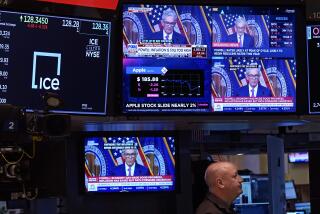Cash Holdings Could Easily Fund a Rally--Question Is, Will They?
- Share via
The cash is there. Now will investors put it to work?
Amid Tuesday’s powerful rebound on Wall Street, some investment pros were focusing less on the day’s activity than on what might come next.
Impressive as the Dow industrials’ 3.8% rise may have been, it recouped just a little more than half of Monday’s 6.4% dive.
That was a less robust rebound than what the Dow experienced after its 7.2% plunge last Oct. 27, when it followed the next day with a 4.7% rally, recouping more than 60% of the previous day’s decline.
Still, the market’s breadth was better this time around: The ratio of rising stocks to falling stocks on the Big Board on Tuesday was 1.65, versus 1.37 last Oct. 28.
Market technicians pore over stats like these for clues to whether the sell-off, and subsequent rebound, suggest the market has reached at least a near-term bottom, or whether the selling has further to run.
But one of the most important numbers now may be this one: $1.23 trillion.
That was the record sum in money market mutual funds, including taxable and tax-free funds, as of last week. It’s a big chunk of change, and it’s potential fodder for another surge in stock prices--if investors begin to feel better about the market.
Money market fund assets ballooned by $45.4 billion in the four weeks through Aug. 25, a 3.8% jump, as many investors either pulled money from stock funds or opted to put new savings into money funds rather than buy stocks in a dicey market.
The $1.23 trillion in money funds now is about half as much as the $2.4 trillion in U.S. stock funds. In other words, for every dollar in stocks funds, investors have about 50 cents sitting in money funds.
The market’s optimists might salivate over the possibilities implied by that hefty cash figure, but the numbers aren’t as bullish as they might appear. While it’s true that money fund assets represent a lot of potential buying power for stocks, history suggests that the vast majority of those money fund dollars don’t budge.
Even as the stock market has rocketed since 1994, money fund assets have mushroomed by $457 billion. So as eager as investors have been to buy stocks, many also have continued to build their cash cushion.
What’s more, the current $1.23 trillion in the money funds isn’t all individual-investor money. More than a third is institutional money.
Still, there’s no question that individuals have stashed a lot of cash in money funds. Many of those dollars may never be removed from those funds. But some significant chunk of the money undoubtedly is being parked in money funds, waiting for a better opportunity--in the stock market, or in some other investment.
Because many investors can shift their money fund dollars into stock funds in the same fund family with just a phone call, the stock market could benefit in a hurry if collective psychology changes from the current apprehensiveness to a got-to-get-in-at-any-price mentality.
That’s not a prediction. But it’s worth remembering that while mutual fund managers have been perhaps overly aggressive in buying stocks in recent years--lowering their fund cash levels to the lowest readings in 20 years--many individual investors have been building up their cash buffers.
Just what it will take to move some of that cash into stocks is anyone’s guess.
But if just $100 billion moved into stocks--just 8.1% of the money fund total--the fireworks could be spectacular.
Meanwhile, Times staff writer Thomas S. Mulligan provides some perspective on just how lousy a month August was for stocks:
For all of August, the Dow dropped 1,344.22 points, or 15.13%. It was by far the largest monthly point drop, more than doubling the 602-point slide of October 1987.
October 1987 was worse in percentage terms, down 23.2%. To find a worse month than that, you’d have to go back to the Great Depression--March 1938, to be specific, when the Dow shed 23.6%.
The 1930s saw five months with declines of 20% or more in the Dow, including the all-time worst month, September 1931, when the Dow fell 30.9%. In October 1929, which climaxed with the nation’s worst-ever market crash--the Dow lost 20.4%.
On the Nasdaq Stock Market, which dates only to 1971, the month just finished was the second-worst on record, after October 1987.
More to Read
Inside the business of entertainment
The Wide Shot brings you news, analysis and insights on everything from streaming wars to production — and what it all means for the future.
You may occasionally receive promotional content from the Los Angeles Times.










